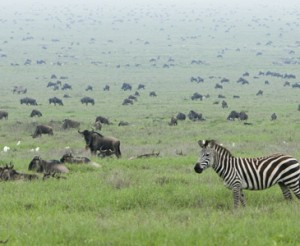Each year more than a million wildebeest, about 300,000 zebra and other antelope start their long trek from Tanzania’s Serengeti Plains, further north to Kenya’s Masai Mara National Reserve. They do it in search of food and water.
The Serengeti plains and the Ngorongoro Conservation areas in Tanzania are home to giant herds of wildebeest, zebra and other ungulates. From December to March is the calving period and by April/May the herds begin to migrate west and north to the grassier plains and woodland of the Serengeti’s western Corridor.
The rain during this time of year makes it difficult to follow the herds during this stage of their migration.
By the end of May, as the rains stop, the wildebeest and zebra gradually start moving north and individual groups begin to congregate and form much larger herds. This is also the time the wildebeest mate. Western Serengeti is the best place to watch the migration unfold.
By July the herds reach their first big obstacle, the Grumeti River. The Grumeti river can get deep in places, especially if the rains have been good. The depth of the river makes drowning a distinct possibility for many wildebeest. As the herds cross, crocodiles are lying in wait for any weak and feeble ungulates that can’t cope with the strong currents or lose their mothers.
These thousands of animals on the plains attract many of Africa’s predators. Lions, leopards, hyenas and wild dogs follow the herds and give visitors excellent chances of seeing a kill in action.
Being a natural event, the timing and location of the migration in Tanzania changes year to year.






